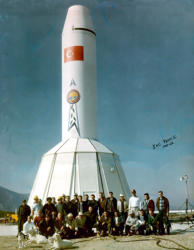HISTORY - Page 43
December without using Army personnel that were in REDSTONE training. At any rate, the Army would
furnish temporary technical assistance and train Air Force specialists. With regard to the training facet,
the Secretary mentioned that it was his understanding that Army responsibilities covered only individual
training, and that unit and readiness training was an Air Force responsibility. Mr. Brucker also pointed out
the importance of an early decision on GSE and training equipment, and that the Army was ready to
furnish the mobile type. He also indicated that major changes to equipment would result in a loss of time
and money. Financial reimbursement was to be made to the Army for all costs occasioned by the JUPITER
program
56
.
In early 1958, the momentum in the JUPITER program was considerably accelerated. For example, on 8-10
January, an operational planning conference was held at ABMA and, from this meeting, the SAC JUPITER
Operational Plan 1-58 resulted. Prior to adoption of the plan, however, a number of other meetings had to
be held to work out the details on specific functions and responsibilities. One of these pertained to
program management. The Air Materiel Command (AMC) had been designated as the executive agent for
the JUPITER, and its Ballistic Missile Office (BMO) had been assigned the role of executing the program.
AMC then took action to establish two project offices: one at AMC/BMO; and the other at ABMA,
designated as the Air Force JUPITER Liaison Office. The latter was comprised of representatives from ARDC,
AMC, Air Training Command (ATC), and SAC. This gave a close coordination at the working technical level
similar to that prevailing in days of the Navy Office
57
.
_____________________________







56. Memo, S/A to S/AF, 31 Dec 57, subj: THOR-JUP Msl Sys's, Hist Off files.
57. DF, Cont Off, ABMA, to Dev Opns Div, et. al., 3 Feb 58, subj: JUP Planning Conf, Hist Off files.



Jupiter SM-78 Weapon System
I&C Team 2, Çigli AB, Turkey 1961-1962 Chrysler Corporation Missile Division

HISTORY - Page 43
December without using Army personnel that were in
REDSTONE training. At any rate, the Army would
furnish temporary technical assistance and train Air
Force specialists. With regard to the training facet, the
Secretary mentioned that it was his understanding
that Army responsibilities covered only individual
training, and that unit and readiness training was an
Air Force responsibility. Mr. Brucker also pointed out
the importance of an early decision on GSE and
training equipment, and that the Army was ready to
furnish the mobile type. He also indicated that major
changes to equipment would result in a loss of time
and money. Financial reimbursement was to be made
to the Army for all costs occasioned by the JUPITER
program
56
.
In early 1958, the momentum in the JUPITER program
was considerably accelerated. For example, on 8-10
January, an operational planning conference was held
at ABMA and, from this meeting, the SAC JUPITER
Operational Plan 1-58 resulted. Prior to adoption of the
plan, however, a number of other meetings had to be
held to work out the details on specific functions and
responsibilities. One of these pertained to program
management. The Air Materiel Command (AMC) had
been designated as the executive agent for the
JUPITER, and its Ballistic Missile Office (BMO) had been
assigned the role of executing the program. AMC then
took action to establish two project offices: one at
AMC/BMO; and the other at ABMA, designated as the
Air Force JUPITER Liaison Office. The latter was
comprised of representatives from ARDC, AMC, Air
Training Command (ATC), and SAC. This gave a close
coordination at the working technical level similar to
that prevailing in days of the Navy Office
57
.
_____________________________
56. Memo, S/A to S/AF, 31 Dec 57, subj: THOR-JUP Msl Sys's, Hist Off files.
57. DF, Cont Off, ABMA, to Dev Opns Div, et. al., 3 Feb 58, subj: JUP Planning Conf, Hist Off files.





















